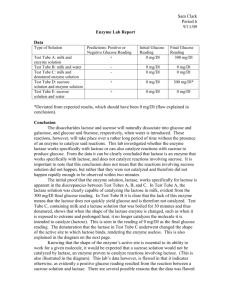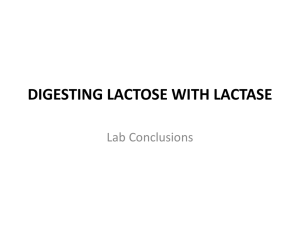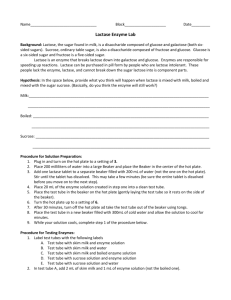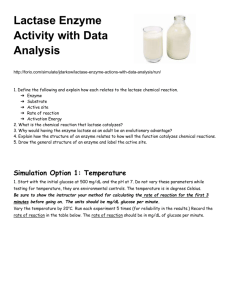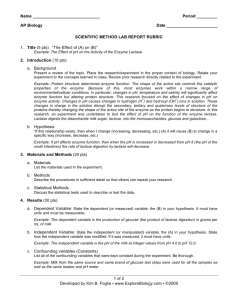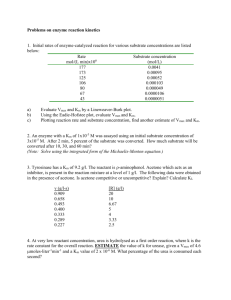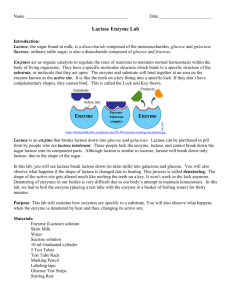Lactase Enzyme Lab Report: Experiment & Analysis
advertisement
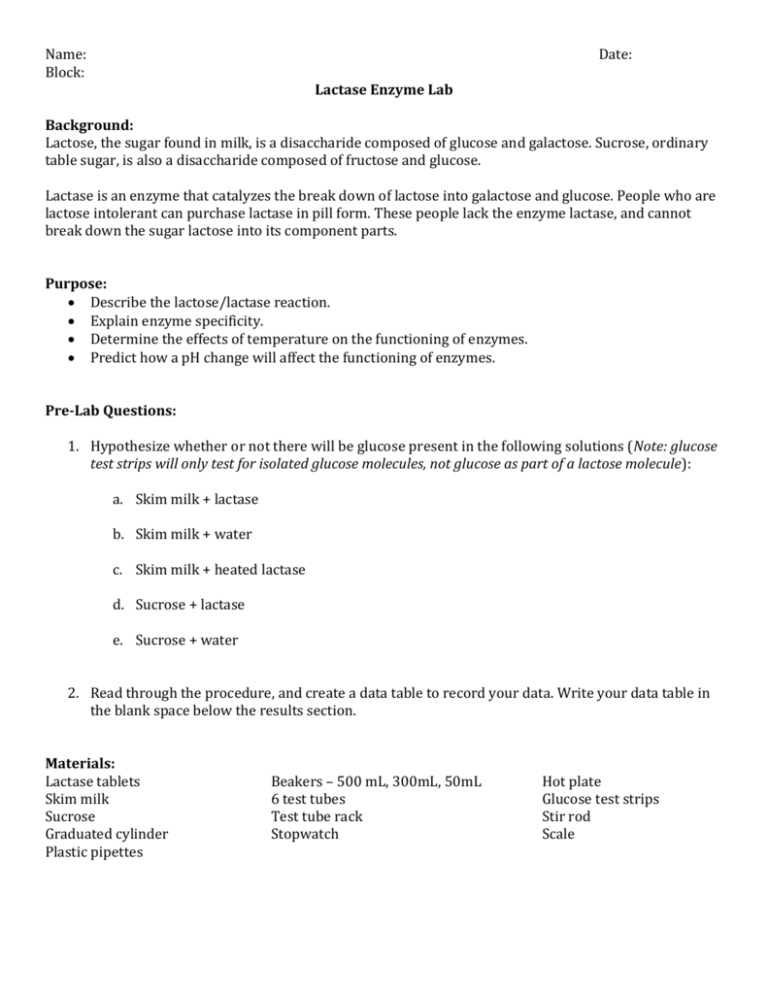
Name: Block: Date: Lactase Enzyme Lab Background: Lactose, the sugar found in milk, is a disaccharide composed of glucose and galactose. Sucrose, ordinary table sugar, is also a disaccharide composed of fructose and glucose. Lactase is an enzyme that catalyzes the break down of lactose into galactose and glucose. People who are lactose intolerant can purchase lactase in pill form. These people lack the enzyme lactase, and cannot break down the sugar lactose into its component parts. Purpose: Describe the lactose/lactase reaction. Explain enzyme specificity. Determine the effects of temperature on the functioning of enzymes. Predict how a pH change will affect the functioning of enzymes. Pre-Lab Questions: 1. Hypothesize whether or not there will be glucose present in the following solutions (Note: glucose test strips will only test for isolated glucose molecules, not glucose as part of a lactose molecule): a. Skim milk + lactase b. Skim milk + water c. Skim milk + heated lactase d. Sucrose + lactase e. Sucrose + water 2. Read through the procedure, and create a data table to record your data. Write your data table in the blank space below the results section. Materials: Lactase tablets Skim milk Sucrose Graduated cylinder Plastic pipettes Beakers – 500 mL, 300mL, 50mL 6 test tubes Test tube rack Stopwatch Hot plate Glucose test strips Stir rod Scale Procedure: Solution Preparation 1. Enzyme solution: Add one lactase tablet to 200mL of water. Stir until tablet has dissolved. 2. Sucrose solution: Add 1g of sucrose to 20mL of water. Stir until the sugar has dissolved. 3. Denatured enzyme solution (already prepared): Add 20mL of enzyme solution to a test tube, and place in a hot water bath for at least 30 minutes. Experimental Procedure 1. Label the test tubes 1-5, where 1 = Skim milk + enzyme solution 2 = Skim milk + water 3 = Skim milk + denatured enzyme solution 4 = Sucrose + enzyme solution 5 = Sucrose + water 2. In test tube 1, add 2mL of skim milk and 1 mL of enzyme solution. 3. Time for 2 minutes and test for glucose with the glucose test strip. Record this in your data table. If glucose was present, mark a (+) in the data table. If glucose was absent, mark a (-) in the data table. 4. In test tube 2, add 2mL of skim milk and 1mL of water. Repeat step 3. 5. In test tube 3, add 2 mL of skim milk and 1mL of denatured enzyme solution. Repeat step 3. 6. In test tube 4, add 2 mL of sucrose solution and 1mL of enzyme solution. Repeat step 3. 7. In test tube 5, add 2mL of sucrose solution and add 1mL of water. Repeat step 3. Results: Data table (don’t forget a title!) Discussion Questions: 1. What type of sugar is found in milk, and what two monosaccharides make up this sugar? 2. What is the difference between lactase and lactose? 3. What is lactose intolerance? 4. What was the purpose of testing the water? 5. Describe the lactose and lactase reaction. Be sure to include the reactants, products, and enzyme. 6. Is the lactose and lactase reaction an example of dehydration synthesis or hydrolysis? Why? 7. Why is the lactose and lactase reaction an example of the “lock and key” model? Explain. 8. A student creates a 6th test tube. He adds 2mL of skim milk, 1mL of enzyme solution, and two drops of hydrochloric acid. What are the predicted results if tested with a glucose test strip after 2 minutes of being mixed together? Explain. Lab Report Overview Cover Sheet: Title in center of page Bottom centered: name (underlined), lab partners, lab due date, class, block, teacher name(s) Introduction: Background info: Enzyme, catalyst, active site, substrate, lactase, lactose, sucrose, lactose intolerance, denaturation Problem/purpose Hypothesis Procedure: Materials Safety Procedure Results: Data table (with title) explained by short blurb (do NOT interpret results here – just state what the results were) Conclusion: Interpret/explain results Relate results to hypothesis Error OR how lab can be improved Discussion: Post-lab questions in paragraph form How lab applies to real life References: APA or MLA – cite class notes if necessary Reminders: Typed, 12 pt. font Section headings NO 1st PERSON!
